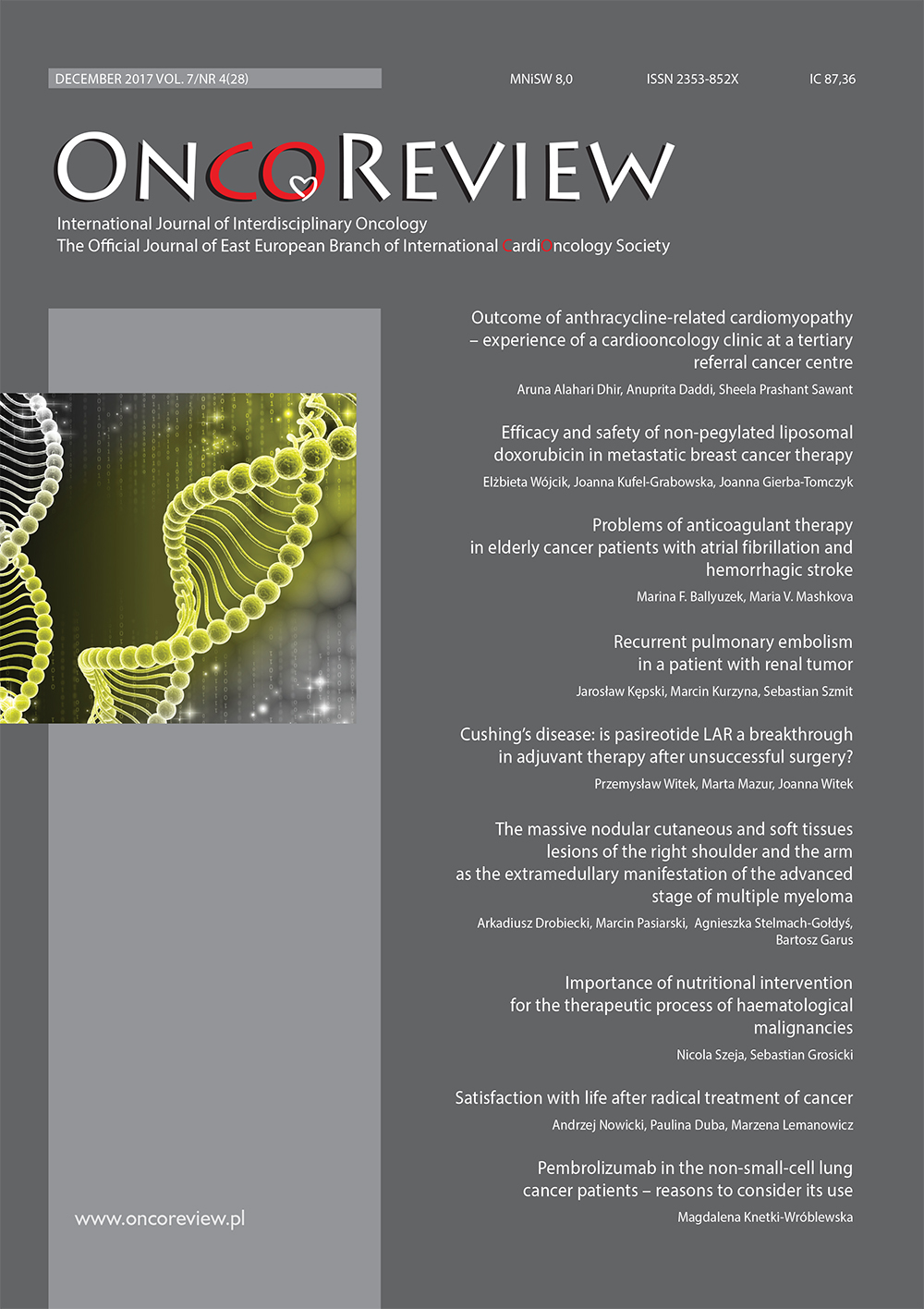The massive nodular cutaneous and soft tissues lesions of the right shoulder and the arm as the extramedullary manifestation of the advanced stage of multiple myeloma Case report
Main Article Content
Abstract
Cutaneous and soft tissue involvement is a very rare manifestation of multiple myeloma. We are describing a woman with the huge multiple plasma cells infiltrations of the soft tissues and the skin of the right shoulder and the arm that had occurred 2.5 years after the diagnosis of multiple myeloma. In the case of the described patient there is a distinct correlation between the appearance of the nodular lesions in soft tissues and the underlying osteolytic changes found in the skeleton. We assumed that the fracture of the right humerus in the past was the beginning of the plasma cells dissemination in the adherent tissues. The skin changes in our patient appeared in the advanced stage of multiple myeloma. There was only transient improvement of cutaneous changes after the chemotherapy, despite the complete remission of the underlying disease in the bone marrow. Despite of the intensive treatment (chemotherapy, radiotherapy) the patient died 7 months after the first appearance of the skin changes
Downloads
Metrics
Article Details

This work is licensed under a Creative Commons Attribution-NonCommercial 4.0 International License.
Copyright: © Medical Education sp. z o.o. This is an Open Access article distributed under the terms of the Attribution-NonCommercial 4.0 International (CC BY-NC 4.0). License (https://creativecommons.org/licenses/by-nc/4.0/), allowing third parties to copy and redistribute the material in any medium or format and to remix, transform, and build upon the material, provided the original work is properly cited and states its license.
Address reprint requests to: Medical Education, Marcin Kuźma (marcin.kuzma@mededu.pl)
References
2. Kois JM, Sexton FM, Lookingbill DP. Cutaneous manifestations of multiple myeloma. Arch Dermatol 1991; 127: 69-74.
3. Requena L, Kutzner H, Palmedo G et al. Cutaneous involvement in multiple myeloma: a clinicopathologic, immunohistochemical, and cytogenetic study of 8 cases. Arch Dermatol 2003; 139: 475-486.
4. Bayer-Garner IB, Smoller BR. The spectrum of cutaneous disease in multiple myeloma. J Am Acad Dermatol 2003; 48: 497-507.
5. Green T, Grant J, Pye R, Marcus R. Multiple primary cutaneous plasmacytomas. Arch Dermatol 1992; 128: 962-965.
6. Procopiou M, Hügli A. A 29 year-old man with multiple myeloma presenting with subcutaneous masses. University Hospital Geneva, Department of Internal Medicine, Switzerland.
7. Garcia-Malo MD, Vallejo C, Vincente V. IgA multiple myeloma with multiple cutaneous plasmacytomas. Haematologica 2001; 86: 1118.
8. Kato N, Kimura K, Yasukawa K, Aikawa K. Metastatic cutaneous plasmacytoma: a case report associated with IgA lambda multiple myeloma and a review of the literature of metastatic cutaneous plasmacytomas associated with multiple myeloma and primary cutaneous plasmacytomas. J Dermatol 1999; 26: 587-594.
9. Rosenblum MD, Bredeson CN, Chang CC, Rizzo JD. Subcutaneous plasmacytomas with tropism to sites of previous trauma in a multiple myeloma patient treated with an autologous bone marrow transplant. Am J Hematol 2003; 72: 274-277.
10. Shpilberg O, Yaniv R, Levy Y et al. Huge cutaneous plasmacytomas complicating multiple myeloma. Clin Exp Dermatol 1994; 19: 324-326.
11. Vianelli N, Tosi P. Plasmacytoma with cutaneous and pleural involvement. Haematologica 1999; 84: 559.
12. Wong DA, Hunt MJ, Stapleton K. IgA multiple myeloma presenting as an acquired bullous disorder. Australas J Dermatol 1999; 40: 31-34.
13. Patterson JW, Parsons JM, White RM et al. Cutaneous involvement of multiple myeloma and extramedullary plasmacytoma. J Am Acad Dermatol 1988; 19: 879-890.
14. Patel K, Carrington PA, Bhatnagar S et al. IgD myeloma with multiple cutaneous plasmacytomas. Clin Lab Haematol 1998; 20: 53-55.

